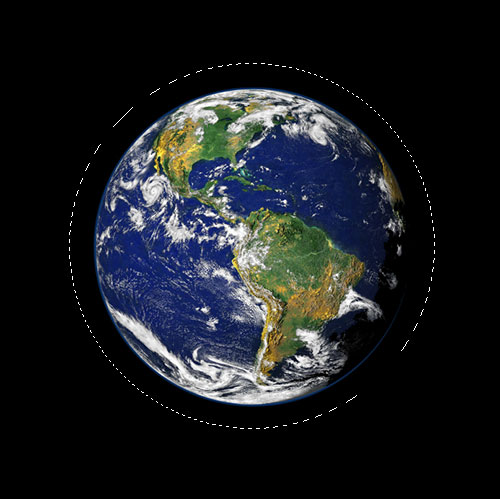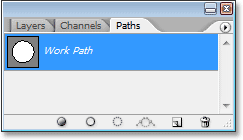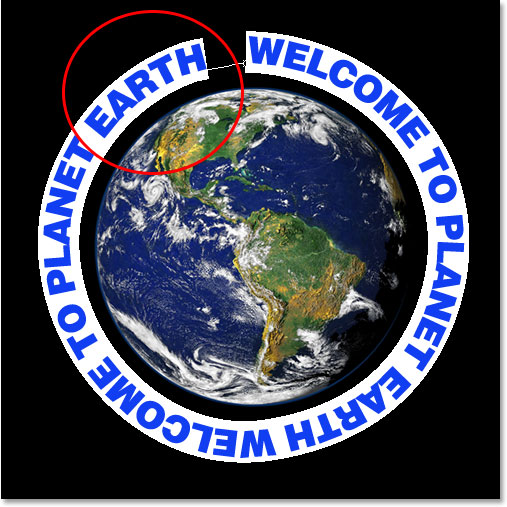In this Photoshop Text Effects
tutorial, we're going to learn how to easily wrap text around a 3D
object in Photoshop, without the need for any 3D software. We're going
to be wrapping our text around a planet, but you can use this same basic
technique to wrap text around just about anything. You'll need
Photoshop CS or higher for this tutorial, since we'll be using
Photoshop's "text on a path" feature, and then we'll be using Free
Transform to reshape our text into a 3D perspective. Finally, we'll be
using a layer mask to hide the text where it passes behind the object,
giving us our final 3D effect.
Here's the image of the planet (good old Planet Earth) I'll be wrapping the text around:

The original image.
And here's what the image will look like after wrapping our 3D text around it:

The final "wrap text in 3D" result.
Step 1: Select The Elliptical Marquee Tool
The first thing I need to do for this effect is to drag out a
circular selection around the planet, and for that, I'll use the tool
that Photoshop includes for just such a task, the Elliptical Marquee Tool.
Select it from the Tools palette. By default, it's hiding behind the
Rectangular Marquee Tool, so you'll need to click on the Rectangular
Marquee Tool and hold your mouse down for a second or two until the
small fly out menu appears, and then select the Elliptical Marquee Tool
from the list:

Select the Elliptical Marquee Tool from the Tools palette.
Step 2: Drag A Selection Around The Object, A Bit Larger Than The Object Itself
With my Elliptical Marquee Tool selected, I'm going to position my
mouse as close to the center of the planet as possible to start with.
Then I'm going to hold down my Shift key to constrain my selection to a perfect circle and I'm going to hold down my Alt (Win) / Option
(Mac) key to tell Photoshop to use the point I'm about to click on as
the center of my selection, so the selection extends out in all
directions from that point. Then I'm simply going to click in the center
of the planet and drag out a selection until my selection is a bit
larger than the planet, giving my text room to wrap around it.
Chances are, the spot where I initially clicked my mouse was not the
dead center of the planet, which means my selection will need to be
repositioned. To move the selection around on the screen and reposition
it as I'm dragging it out, I'll hold down my spacebar,
which allows me to move the selection around wherever I want it, and
then I'll release the spacebar to continue dragging the selection
larger.
Continue dragging and repositioning the selection until it's properly
aligned with the object and a bit larger than the object itself:

The circular selection is now added around the object.
Step 3: Convert The Selection Into A Path
We now have our selection around the object, and we're going to use
it to add our text to the image, using Photoshop's "text on a path"
feature. Problem is, our selection is a selection, not a path.
Fortunately, Photoshop makes it easy to convert any selection into a
path. To do that, switch over to your Paths palette,
which you'll find grouped in by default with the Layers and Channels
palettes. The Paths palette will appear empty, since we currently don't
have any paths in our document. To convert the selection into a path,
click on the Make Work Path From Selection icon at the bottom of the Paths palette (it's the third icon from the right):

Click on the "Make Work Path From Selection" icon.
As soon as you click on the icon, Photoshop converts the selection
into a path, and the new "Work Path" appears in the Paths palette:

The Paths palette now shows the newly created path.
And if we look back in our image, we can see that the dotted lines of
our selection have been replaced with a thin solid line, which is our
path:

The selection around the planet has been converted into a path.
We can now use this path, along with the "text on a path" feature in
Photoshop CS and higher, to add our text, which we'll do next.
Step 4: Select The Type Tool
Switch back over to your Layers palette at this point. It's time to add our text. For that, we need to use Photoshop's Type Tool, so either select if from the Tools palette or press the letter T on your keyboard:

Select the Type Tool.
With the Type Tool selected, go up to the Options Bar at the top of
the screen and select your font and font size. This 3D effect works best
if you use a font with thick letters, so I'm going to choose Helvetica
Black as my font. You can choose whichever font you like from the ones
you have installed on your system, but again, try to pick one with nice
thick letters, and also one that's easily readable. You'll need to
experiment with the size of your font, since it will depend a lot on the
size of the object you're wrapping your text around and even more so on
the size and resolution of the image you're using. I'm using a 14pt
font size for this tutorial, but again, you'll need to experiment on
your own with your image:

Select your font and font size in the Options Bar.
Step 5: Choose A Color For Your Text
While you're up in the Options Bar, let's choose a color for our text. To do that, click on the color swatch:

Click on the color swatch in the Options Bar to select a color for the text.
This brings up Photoshop's Color Picker where you
can choose whichever color you like for your text. I'm going to choose a
bright yellowish-orange color, which should stand out nicely against
the mostly blue planet as well as the black background:

Use the Color Picker to choose a color for your text.
Click OK once you've chosen your color to exit out of the dialog box.
Step 6: Type Your Text Along The Circular Path
With our font, font size and text color selected, we can add our
text, and we want to add it so that it follows along the circular path
we've created. To do that, move your mouse cursor over the part of the
path where you want to begin typing. I'm going to start my text
somewhere along the top of the path. As you move your mouse cursor over
the path, you'll notice that the cursor changes from having a dotted
square around it to a squiggly line running through it. That squiggly
line tells you that you're about to type directly on the path and that
your text will follow along the shape of the path, which is exactly what
we want. To add your type, simply click on the path and begin typing.
The effect will work best if you use all capital letters. I'm going to
type "WELCOME TO PLANET EARTH":

Click directly on the path and begin typing to have the text follow along the shape of the path.
Since I want my text to appear to fully wrap around the planet, I'm
going to type the exact same sentence again at the end of it:

Add enough text to wrap completely around the object.
If you look closely, you can see that I've run into a small problem.
There isn't enough space along my path to fit in all my text, and the
word "EARTH" in the top left has been cut off. To fix that, I'm going to
double-click directly on the type layer's thumbnail in the Layers
palette, which is going to tell Photoshop to select all of my text at
once:

Double-click on the type layer's thumbnail in the Layers palette to select all the text.
My text will appear highlighted in white in my image. Then, with my text selected, I'm going to hold down my Alt (Win) / Option key and press the left arrow key
on my keyboard a couple of times to close up the space between the
letters until there's enough room to fit in all of my text and the word
"EARTH" appears:

Hold down "Alt" (Win) / "Option" (Mac) and use the left or right arrow keys to add or remove space between the letters.
To space both sentences an equal distance apart and close up that
large gap at the top, I'm going to click my mouse between the two
sentences at the bottom (between the words "EARTH" and "WELCOME" ) and
again holding down Alt (Win) / Option (Mac), I'm going to press my left bracket key a few times to add a little extra space between the two words until the text looks equally balanced all along the path.
When I'm happy with the spacing of my text, I'm going to press Ctrl+H (Win) / Command+H (Mac) to hide the path from view, leaving me with just my planet and my text circled and nicely spaced around it:

The text now circles around the outside of the planet.
Our text is now circling around the planet but it looks very much
two-dimensional and not very interesting. We're going to bring it into
the third dimension next.
Step 7: Use Free Transform To Distort The Text Into A 3D Perspective
Now comes the fun part. We're going to convert our text into 3D! Or at least, we're going to create the illusion that it's 3D, anyway. Photoshop isn't a true 3D program, but we can still fake it. To do that, we'll use Photoshop's Free Transform command. With the type layer selected in the Layers palette, use the keyboard shortcut Ctrl+T (Win) / Command+T (Mac) to bring up the Free Transform handles around the text:

Press "Ctrl+T" (Win) / "Command+T" (Mac) to access the Free Transform handles.
To bend my text into a 3D perspective, I'm going to hold down Ctrl+Alt (Win) / Command+Option
(Mac) and then drag the Free Transform handle in the top right corner
in towards the center of the planet. The further inward I drag, the more
of a 3D perspective I create with my text:

Drag the top right corner handle in towards the center of the object to create the 3D perspective.
When you're happy with the way your text looks, press Enter (Win) / Return (Mac) to accept the transformation:

Press "Enter" (Win) / "Return" (Mac) to accept the transformation.
Step 8: Add A Layer Mask To The Text Layer
Things are definitely starting to look more 3D, except for one minor
detail. Our text isn't wrapping around the object, it's just sitting
there in front of it. To really give us a 3D look, we need to hide the
text in the areas where it's supposed to be behind the object, and we
can do that using a layer mask. With the text layer still selected,
click on the Layer Mask icon at the bottom of the Layers palette:

Add a layer mask to the text layer by clicking on the "Layer Mask" icon.
This adds a layer mask to the text layer, and it also adds a layer
mask thumbnail in the Layers palette. We can tell that the layer mask is
currently selected because the thumbnail has a white highlight border
around it:

The layer mask thumbnail with a white highlight
border around it, telling us that the layer mask, not the layer itself,
is selected.
Step 9: Make A Selection Around Your Object
I want to hide the text that's supposed to be behind the planet, so I'm going to grab my Elliptical Marquee Tool
once again and, just as I did at the beginning of this tutorial, I'm
going to use it to drag out a selection around the planet. This time
though, I want my selection to extend only to the edge of the planet,
not an area around the outside of it like we did before. So once again,
I'm going to click approximately in the center of the planet, and
holding down Shift+Alt (Win) / Shift+Option
(Mac), I'm going to drag out a circular selection around the planet. If
I need to reposition my selection as I'm dragging, I'll again hold down
my spacebar and move the selection around on the screen as needed, then I'll release the spacebar and continue dragging.
Here's my image with my planet selected:

The planet is now selected.
Step 10: Paint With Black Inside The Selection To Hide The Text
With our layer mask added to the text layer and a selection around
the planet, we can easily hide the text that's supposed to be behind the
planet by simply painting over the text. First we need our brush, so
select the Brush Tool from the Tools palette, or press B on your keyboard:

Select the Brush Tool.
Then, with black as your Foreground color, simply paint over the text
you want to hide. Since we're painting on the layer mask, not the layer
itself, we won't be painting black on the image. Instead, anywhere
where we paint with black will hide the contents of the layer. I need to
hide the text in the top part of the planet, so I'll paint over it with
my Brush Tool. Thanks to the selection I created, I don't have to worry
about being sloppy with my brush and accidentally painting beyond the
edge of the planet, since Photoshop will only allow me to paint inside
the selection. Anywhere I paint outside of it is ignored:

Paint over the text you want to hide with the Brush Tool. Only the text inside the selection will be affected.
Continue painting over the text until you've hidden everything that needs to be hidden. When you're done, press Ctrl+D (Win) / Command+D (Mac) to remove the selection. If your path under the text became visible again, press Ctrl+H (Win) / Command+H (Mac) to hide it from view.
Here's my image after painting over the text along the top to hide
it, creating the illusion that the text is now circling the planet in
3D:

The final "wrap text in 3D" result.
Step 11: Add A Gradient Overlay Layer Style
To finish things off, let's add a bit of lighting to our text using one of Photoshop's Layer Styles. Click on the Layer Styles icon at the bottom of the Layers palette:
Click on the "Layer Styles" icon.
Then select Gradient Overlay from the list:

Select "Gradient Overlay".
This brings up the Layer Style dialog box set to the Gradient Overlay
options in the middle column. By default, Photoshop gives us a black to
white gradient, which is what we want. Rather than using the gradient
to colorize our text though and make it black and white, we're going to
use it to add a simple lighting effect. First, change the Blend Mode option at the top from "Normal" to Vivid Light
by clicking on the down-pointing arrow to the right of the word
"Normal" and selecting "Vivid Light" from the list. Then lower the Opacity value down to about 60%. Finally, change the Angle option at the bottom to 0°:

The Gradient Overlay options in the Layer Style dialog box.
Click OK when you're done to exit out of the dialog box and apply the
Gradient Overlay style to the text, and you're done! Here's the final
effect with my simple lighting effect added to the text:

The final 3D effect.
No comments:
Post a Comment